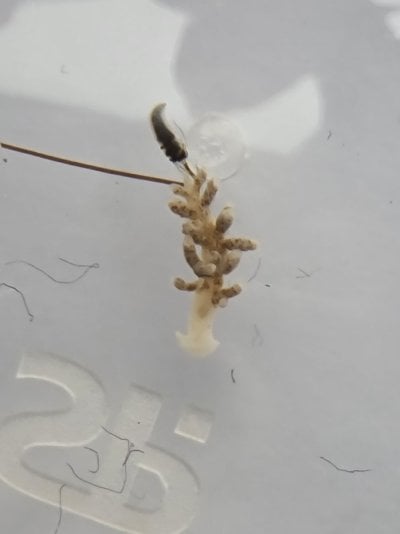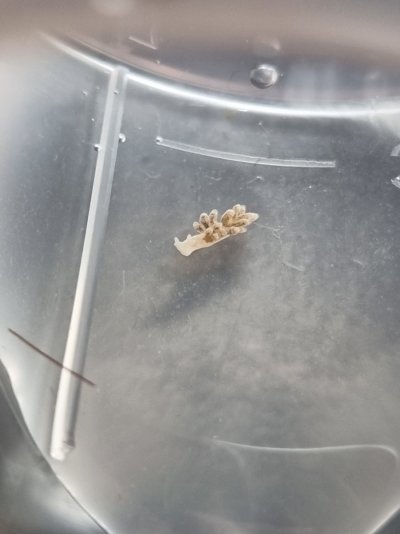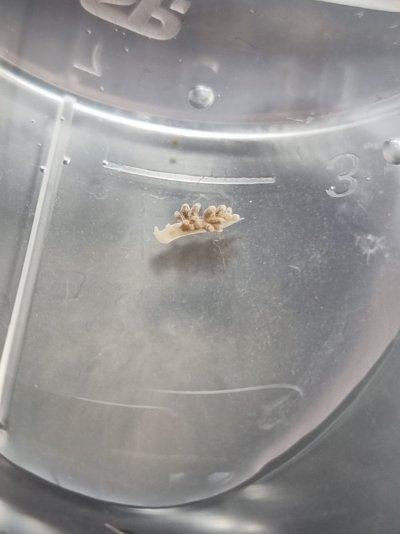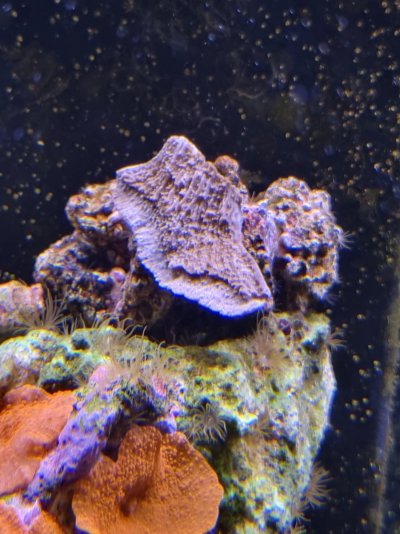- Joined
- Feb 25, 2020
- Messages
- 1,729
- Reaction score
- 3,211
Identification:
Montipora Eating Nudibranches are a fairly common aquarium pest that will feed on any montipora species and even some others like select chalices, scrolls etc. There are over 2000 known species of Nudibranchs and all of them have very select diets. They were each put on this world to eat one thing and they do a good job at it. Montipora eating types all seem to share the same color and shape but can vary from 1/8in to 3/4in long. Ive personally come across 2 species that eat montipora.
The first of which is larger and can grow to be about 1/2-3/4in. Here is one on a montipora spongodes that had just laid some eggs. Each egg sack contains quite a few baby nudis. It only takes a few days for nudibranches to hatch and another couple days to reach sexual maturity. They lay lots of eggs in short intervals and with such a quick hatch and maturity rate they can multiply very fast when theres enough available food.

Here is another type of montipora eating nudi but these ones stay small reaching a maximum size of 1/4in. They are much harder to spot and hatchlings are nearly microscopic.

A common misidentification is between berghia nudibranchs and montipora eating nudis. The berghias eat aiptasia but look fairly similar. The biggest difference is the berghias have long tentacles on their heads and the frills on their backs are streamline and pointed.
(Images off google that i put together for easy comparison)

Symptoms that your montipora may be infected, include blotchy areas of dead tissue, looking fuzzy near the edges of the tissue (the nudis), and just tissue recession. Nudibranchs are mostly active at night and can be hard to spot during the day. In a healthy aquarium where these nudis are newly introduced, montipora can still grow and thrive even when infected with them. They do have some natural defense in their slime coat to hold them back but if the coral ever gets stressed you will see the nudi population boom literally over night. Once theres enough of them in the tank, even healthy montipora will quickly be devoured.
Treatment:
The best form of treatment is always prevention. Always dip and inspect new corals for pests, if possible quarantine is even better. Buying from top venders like wwc, Jason fox, tsa etc is a great way to insure pest free corals, but i still recommend dips and inspection.
Treatment for all nudibranchs is generally the same. Ideally all species that the nudi targets should be removed from the display tank and put in quarantine. Dip the affected corals and any other corals in the tank of similar species twice a week for 4-6 weeks until you havent seen any nudis for atleast a month. The reason for twice weekly is because the dip does not kill the eggs and this covers their reproduction cycle. Before the dip inspect the corals and manually remove any nudis and eggs you find. During the dip take a tooth brush and brush the bases of the coral and affected areas. I prefer iodine based dips and dip for 20-30mins. After i also like to cut the bases off or super glue any nooks or cracks shut that they could hide in to make sure im covering places they cant be seen. Ive had success waiting 2 months before adding the corals back. the nudibranchs left in the display should have no doubt starved. You can do this without the qt tank but expect to have to continue dipping for much longer. Wrasses are also a great way to reduce nudi populations, they do a good job at pecking off strays that venture out during the day, but wrasses still sleep at night when the nudis are most active so they arent the best solution.
Heres a video i took today of a monti eating nudi in an iodine dip. (Let me know if the instagram link isnt working i couldnt upload the video to r2r)
 www.instagram.com
www.instagram.com
Hope this helps someone!
Montipora Eating Nudibranches are a fairly common aquarium pest that will feed on any montipora species and even some others like select chalices, scrolls etc. There are over 2000 known species of Nudibranchs and all of them have very select diets. They were each put on this world to eat one thing and they do a good job at it. Montipora eating types all seem to share the same color and shape but can vary from 1/8in to 3/4in long. Ive personally come across 2 species that eat montipora.
The first of which is larger and can grow to be about 1/2-3/4in. Here is one on a montipora spongodes that had just laid some eggs. Each egg sack contains quite a few baby nudis. It only takes a few days for nudibranches to hatch and another couple days to reach sexual maturity. They lay lots of eggs in short intervals and with such a quick hatch and maturity rate they can multiply very fast when theres enough available food.
Here is another type of montipora eating nudi but these ones stay small reaching a maximum size of 1/4in. They are much harder to spot and hatchlings are nearly microscopic.
A common misidentification is between berghia nudibranchs and montipora eating nudis. The berghias eat aiptasia but look fairly similar. The biggest difference is the berghias have long tentacles on their heads and the frills on their backs are streamline and pointed.
(Images off google that i put together for easy comparison)
Symptoms that your montipora may be infected, include blotchy areas of dead tissue, looking fuzzy near the edges of the tissue (the nudis), and just tissue recession. Nudibranchs are mostly active at night and can be hard to spot during the day. In a healthy aquarium where these nudis are newly introduced, montipora can still grow and thrive even when infected with them. They do have some natural defense in their slime coat to hold them back but if the coral ever gets stressed you will see the nudi population boom literally over night. Once theres enough of them in the tank, even healthy montipora will quickly be devoured.
Treatment:
The best form of treatment is always prevention. Always dip and inspect new corals for pests, if possible quarantine is even better. Buying from top venders like wwc, Jason fox, tsa etc is a great way to insure pest free corals, but i still recommend dips and inspection.
Treatment for all nudibranchs is generally the same. Ideally all species that the nudi targets should be removed from the display tank and put in quarantine. Dip the affected corals and any other corals in the tank of similar species twice a week for 4-6 weeks until you havent seen any nudis for atleast a month. The reason for twice weekly is because the dip does not kill the eggs and this covers their reproduction cycle. Before the dip inspect the corals and manually remove any nudis and eggs you find. During the dip take a tooth brush and brush the bases of the coral and affected areas. I prefer iodine based dips and dip for 20-30mins. After i also like to cut the bases off or super glue any nooks or cracks shut that they could hide in to make sure im covering places they cant be seen. Ive had success waiting 2 months before adding the corals back. the nudibranchs left in the display should have no doubt starved. You can do this without the qt tank but expect to have to continue dipping for much longer. Wrasses are also a great way to reduce nudi populations, they do a good job at pecking off strays that venture out during the day, but wrasses still sleep at night when the nudis are most active so they arent the best solution.
Heres a video i took today of a monti eating nudi in an iodine dip. (Let me know if the instagram link isnt working i couldnt upload the video to r2r)
Login • Instagram
Welcome back to Instagram. Sign in to check out what your friends, family & interests have been capturing & sharing around the world.
 www.instagram.com
www.instagram.com
Hope this helps someone!
Last edited:























